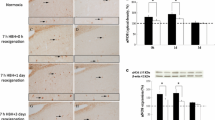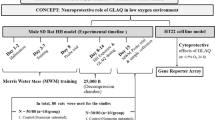Abstract
Hypoxia is an environmental stressor that is known to elicit alterations in both the autonomic nervous system and endocrine functions. The free radical or oxidative stress theory holds that oxidative reactions are mainly underlying neurodegenerative disorders. In fact among complex metabolic reactions occurring during hypoxia, many could be related to the formation of oxygen derived free radicals, causing a wide spectrum of cell damage. In present study, we investigated possible involvement of GABAergic mechanism in the protective effect of zolpidem against acute hypoxia-induced behavioral modification and biochemical alterations in mice. Mice were subjected to acute hypoxic stress for a period of 2 h. Acute hypoxic stress for 2 h caused significant impairment in locomotor activity, anxiety-like behavior, and antinocioceptive effect in mice. Biochemical analysis revealed a significant increased malondialdehyde, nitrite concentrations and depleted reduced glutathione and catalase levels. Pretreatment with zolpidem (5 and 10 mg/kg, i.p.) significantly improved locomotor activity, anti-anxiety effect, reduced tail flick latency and attenuated oxidative damage (reduced malondialdehyde, nitrite concentration, and restoration of reduced glutathione and catalase levels) as compared to stressed control (hypoxia) (P < 0.05). Besides, protective effect of zolpidem (5 mg/kg) was blocked significantly by picrotoxin (1.0 mg/kg) or flumazenil (2 mg/kg) and potentiated by muscimol (0.05 mg/kg) in hypoxic animals (P < 0.05). These effects were significant as compared to zolpidem (5 mg/kg) per se (P < 0.05). Present study suggest that the possible involvement of GABAergic modulation in the protective effect of zolpidem against hypoxic stress.


Similar content being viewed by others
References
Fan LW, Lin S, Pang Y, Rhodes PG, Cai Z (2006) Minocycline attenuates hypoxia-ischemia-induced neurological dysfunction and brain injury in the juvenile rat. Eur J Neurosci 24(2):341–350
Struzik L, Vermani M, Duffin J, Katzman MA (2004) Anxiety sensitivity as a predictor of panic attacks. Psychiatry Res 129(3):273–278
Brown KA, Laferriere A, Lakheeram I, Moss IR (2006) Recurrent hypoxemia in children is associated with increased analgesic sensitivity to opiates. Anesthesiology 105(4):665–669
Harman D (1994) Free radical theory of aging, increasing the functional life span. Ann NY Acad Sci 717:1–15
Shapira S, Sapir M, Wengier A et al (2002) Aging has a complex effect on a rat model of ischemic stroke. Brain Res 925:148–158
Saugstad OD (1996) Oxygen radical and tissue destruction. Biol Neonate 69:190–192
Yu BP (1994) Cellular defense against damage from reactive oxygen species. Physiol Rev 74:139–162
Magalhaes J, Ascesao A, Soares JM et al (2005) Skeletal muscle ultrastructural and plasma biochemical signs of endothelium dysfunction induced by a high altitude expedition (Pumori. 7161m). Bas Appl Myol 91:185–191
Jayalakshmi K, Sairam M, Singh SB et al (2005) Neuroprotective effect of N-acetyl cysteine on hypoxia induced oxidative stress in primary hippocampal culture. Brain Res 10469:97–104
Nelson DL, Cox MM (2004) Lehninger Principle of Biochemistry, 3rd edn. Macmillan Worth Publishers, UK, p 542
Calabrese V, Bates TE, Stella AMG (2000) NO synthase and NO dependent signal pathways in brain aging and neurodegenerative disorders: the role of oxidant/antioxidant balance. Neurochem Res 2:1315–1341
Mombereau C, Kaupmann K, Froestl W et al (2004) Genetic and Pharmacological evidence of a role for GABAB receptors in the modulation of anxiety and antidepressant like behaviour. Neuropsychopharmacology 29:1050–1062
Wood JD, Watson WJ, Drucker AJ (1968) The effect of hypoxia on brain gamma-amino-butyric acid levels. J Neurochem 15:603–608
Iversen K, Hedner T, Lundberg P (1983) GABA concentrations and turnover in neonatal rat brain during asphyxia and recovery. Acta Physiol Scand 118:91–94
Yelmen NK (2004) The role of gamma amino butyric acid and glutamate for hypoxia ventilatory response in anesthetized rabbits. J Exp Med 203:219–232
Madl JE, Royer SM (2000) Glutamate dependence of GABA levels in neurons of hypoxia and hypoglycemic rat in hippocampal slices. Neuroscience 96:657–664
Endo K, Hori T, Abe S et al (2007) Alterations in GABA (A) receptor expression in neonatal ventral hippocampal lesioned rats: comparison of prepubertal and postpubertal periods. Synapse 61:357
Bremmer JD, Inis RB, Southwick SM et al (2000) Decreased benzodiazepine receptor binding in prefrontal cortex in combat-related posttraumatic stress disorder. Am J Psychiatry 157:1120–1126
Chouniard G, Beauclair L, Belanger MC (1998) Gabapentin: long-term antianxiety and hypnotic effects in psychiatric patients with comorbid anxiety-related disorders. Can J Psychiatry 43:305–311
Gal EM, Hwater RD, Milland SA (1968) Studies on the metabolism of 5 hydroxy tryptamine (serotonin) IV. Hydroxylation and amines in cold stressed reserpinised rat. Proc Soc Exp Biol Med 128:412–415
Cui XY, Zhao X, Chu QP et al (2006) Influence of diltiazem on the behavior of zolpidem treated mice in the elevated plus maze test. J Neural Transm 7:506–535
Thorat SN, Kulkarni SK (1990) The protective effect of adenosine agents, RO 54864 and carbamazipine against hypoxic stress induced neurotoxicity in mice. Methods Find Exp Clin Pharmacol 12:17–22
D’Amour EF, Smith DL (1996) A method for determines loss of pain sensation. J Pharmaco Exp Ther 72:74–79
Kulkarni SK (1999) In: Vallabh Prakashan (ed) Handbook of experimental pharmacology. Vallabh Prakashan, New Delhi, pp 123–125
Kulkarni SK, Reddy DS (1996) Animal behavioral models for testing antianxiety agents. Method Find Exp Clin Pharmacol 18:219–230
Reddy DS, Kulkarni SK (1998) Possible role of nitric oxide in the nootropic and antiamnesic effects of neurosteroids on aging and dizocilpine-induced learning impairment. Brain Res 799:215–229
Wills ED (1966) Mechanism of lipid peroxide formation in animal tissues. Biochem J 99:667–676
Ellman GL (1959) Tissue sulfhydryl groups. Arch Biochem Biophys 82:48670–48677
Green LC, Wagner DA, Glagowski J (1982) Analysis of nitrate, nitrite and [15N] nitrate in biological fluids. Anal Biochem 126:131–138
Lowry OH, Rosenberg NJ, Farr AL et al (1959) Protein measurement with the Folin-phenol reagent. J Biol Chem 193:265–275
Luck HC (1971) In: Bergmeyer H (ed) Methods of enzymatic analysis. Academic, New York, pp 885–894
Gamal H, El-Sokkary D, Bothaina MK, Hala AY (2006) Role of melatonin in reducing hypoxia-induced oxidative stress and morphological changes in the liver of male mice. Eur J Pharmacol 540:107
Jefferson JA, Simoni J, Escudero E, Hurtado ME, Swenson ER, Wesson DE, Schreiner GF, Schoene RB, Johnson RJ, Hurtado A (2004) Increased oxidative stress following acute and chronic high altitude exposure. High Alt Med Biol 5:61–64
Metz GA, Jadavji NM, Smith LK (2005) Modulation of motor function by stress: a novel concept of the effects of stress and corticosterone on behavior. Eur J Neurosci 22:1190–1200
Sevgi S, Ozek M, Eroglu L (2006) L-NAME prevents anxiety-like and depression-like behavior in rats exposed to restraint stress. Methods Find Exp Clin Pharmacol 28:95–99
Torres IL, Vasconcellos AP, Silveira Cucco SN et al (2001) Effect of repeated stress on novelty-induced antinociception in rats. Braz J Med Biol Res 34:241–244
Dhir A, Padi SV, Naidu PS et al (2006) Protective effect of Naproxen (non selective COX inhibitor) or rofecoxib (selective COX inhibitor) on immobilization stress induced behavioral and biochemical alterations in mice. Eur J Pharmacol 27:192–198
Rossignol R, Ebigwel-Ibru M (1980) Drugs against brain hypoxia. Trends Pharmacol Sci 1:287–289
Spagnoli A, Tognoni G (1983) Cerebro active drugs. Clinical pharmacology and therapeutic role in cerebrovascular disorders. Drugs 26:44–69
Imaizumi SL, Kayama T, Suzuki J (1984) Chemiluminiscence in hypoxic brain—the first report. Correlation between energy metabolism and free radical reaction. Stroke 15:1061–1065
Siesjo BK (1981) Cell damage in brain: a speculative synthesis. J Cereb Blood Flow Metab 1:155–185
Kalimo H, Rehncrona S, Soderfeldt B et al (1981) Brain lactic acidosis and ischemia cell damage. 2. Histopathology. J Cereb Blood Flow Metab 1:313–327
Rehncrona S, Rosen I, Siesjo BK (1981) Brain lactic acidosis and ischemia cell damage. 1. J Cereb Blood Flow Metab 1:297–231
Demopoulos H, Flamm E, Seligman ML et al (1977) Molecular pathology of lipids in CNS membranes. In: Jobsis FF (ed) Oxygen and physiological functions. Professional Information Library, Dallas, pp 491–508
Dringen R, Pawlowski PJ, Hirrlinger J (2005) Peroxide detoxification by brain cells. J Neurosci Res 79:157–165
Sherki YG, Melemed E, Offen D (2001) Oxidative stress induced-neurodegenerative diseases: the need for antioxidants that penetrate the blood brain barrier. Neuropharmacology 40:959–975
Floyd RA (1990) Role of oxygen free radicals in carcinogenesis and brain ischemia. FASEB J 4:2587–2597
Feng Y, Le Blanc MH, Le Blanc EB (2000) Desmethyl trilizad improves neurologic function after hypoxic ischemia brain injury in piglets. Crit Care Med 28:1431–1438
Reiter RJ (1998) Oxidative damage in the central nervous system: protection by melatonin. Prog Neurobiol 56:359–384
Molodavkin GM, Voronina TA, Aldarmaa ZH et al (2004) Stress-induced alteration of the antiaggressive effect of anxiolytics. Eksp Klin Farmacol 67:3–6
Nazar M, Jessa M, Plaznik A (1997) Benzodiazipine-GABA-A receptor complex ligands in two models of anxiety. J Neural Transm 104:733–746
O’Connor TM, O’Halloran DJ, Shanahan F (2000) The stress response and the hypothalamo-pituitary-adrenocortical axis: from molecule to melancholia. QJ Med 93:323–333
Murison R, Overmier JB (1993) Parallelism among stress effects on ulcer, immunosuppression and analgesia: commonality of mechanisms?. J Physiol Paris 87:253–259
Lippa AS, Klepner CA, Yunger L et al (1978) Relationship between Benzodiazipine receptors and experimental anxiety in rats. Pharmacol Biochem Behav 9:853–856
Medina J, Novas ML, De Robertis E (1983) Changes in benzodiazipine receptors by acute stress: different effect of chronic diazepam or RO 15-1788 treatment. Eur J Pharmacol 96:181–185
Miller LG, Thompson ML, Greenblatt DJ et al (1987) Rapid increase in brain benzodiazepine receptor binding following defeat stress in mice. Brain Res 414:395–400
Weizman R, Weizman A, Kook KA et al (1989) Repeated swim stress alters brain benzodiazepine receptors measured in vivo. J Pharmacol Exp Ther 249:701–707
Dombrowski PA, Fernandes LH, Andreatini R (2006) Picrotoxin blocks the anxiolytic- and panicolytic-like effects of sodium valproate in the rat elevated T-maze. Eur J Pharmacol 10:72–76
Dalvi A, Rodgers RJ (2001) Anxiolytic effects of valproate and diazepam in mice are differentially sensitive to picrotoxin antagonism. Pharmacol Biochem Behav 68:23–32
Author information
Authors and Affiliations
Corresponding author
Rights and permissions
About this article
Cite this article
Kumar, A., Goyal, R. Possible GABAergic Modulation in the Protective Effect of Zolpidem in Acute Hypoxic Stress-induced Behavior Alterations and Oxidative Damage. Neurochem Res 33, 370–377 (2008). https://doi.org/10.1007/s11064-007-9431-9
Received:
Accepted:
Published:
Issue Date:
DOI: https://doi.org/10.1007/s11064-007-9431-9




